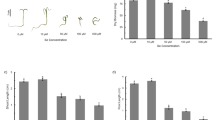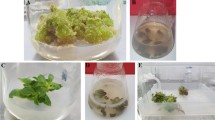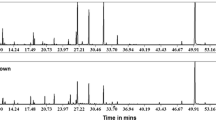Abstract
Astragalus is a medicinal plant rich in phenolic compounds, saponins, and polysaccharide gum tragacanth which are potentially important in traditional medicine. This makes the plant endangered because of uncontrolled collection from nature. Plant cell culture has been carried out for the preservation of medicinal plant resources and efficient production of pharmaceutically important primary and secondary metabolites. A few species of Astragalus accumulate Selenium (Se). It is not an essential micronutrient but a beneficial for certain plants in the promotion of their growth and antioxidant activities. In the present study, first a rapid growing cell line of Astragalus gossypinus was established. Then the impact of Se on the primary (gum tragacanth production) and secondary (phenolic and saponin compounds enhancement) metabolism of suspension-cultured A. gossypinus cells was evaluated. The cells in their logarithmic growth phase were exposed to 0, 0.5 2.5, 12.5, and 62.5 µM Se in the form of sodium selenate for one week. No significant metabolic changes were observed in A. gossypinus cells up to 2.5 µM Se supply. Higher Se concentrations however significantly increased soluble sugar and amino acids contents, the total amount of exopolysaccharides, enzymatic and non-enzymatic radical scavenging system. The result showed that glutathione was the main non-enzymatic compartment that functions in an intricate network with phenolic compounds. In this network increase of oxidants scavenging capacity was initiated by caffeic acid, tannins, and phlobaphene while an increase of saponin production was triggered by salicylic acid.
Key message
This paper clarifies how Se treatment reprogrammed primary metabolism of Astragalus gossypinus cells and modulated oxidative status thereby altered phenolics and saponins and activated defense system.




Similar content being viewed by others
Data availability
The data supporting the findings of this study are available from the corresponding authors, upon request.
Code availability
Not applicable.
Abbreviations
- DPPH:
-
2.2’Diphenylpicrylhydrazyl radicals
- CAT:
-
Catalase
- EtOAC:
-
Ethyl acetate
- EtOH:
-
Ethanol
- EPS:
-
Exopolysaccharides
- FW:
-
Fresh weight
- GPX:
-
Glutathione peroxidase
- PO:
-
Guaiacol peroxidase
- H2O2 :
-
Hydrogen peroxide
- MDA:
-
Malondialdehyde
- MeOH:
-
Methanol
- NO:
-
Nitric oxide
- PAL:
-
Phenylalanine ammonia-lyase enzyme
- PPO:
-
Polyphenol oxidase
- RSC:
-
Radical scavenging capacity
- GSH:
-
Reduced glutathione
- SOD:
-
Superoxide dismutase
- TCA:
-
Trichloroacetic acid
- TFA:
-
Trifluoroacetic acid
- TAL:
-
Tyrosine ammonia-lyase enzyme
References
Amiri MS, Joharchi MR, Nadaf M, Nasseh Y (2020) Ethnobotanical knowledge of Astragalus spp.: the world’s largest genus of vascular plants. Avicenna J Phytomed 10(2):128
Baker CJ, Mock NM (1994) An improved method for monitoring cell death in cell suspension and leaf disc assays using evans blue. Plant Cell Tissue Organ Cult 39:7–12
Balaghi S, Mohammadifar MA, Zargaraan A, Gavlighi HA, Mohammadi M (2011) Compositional analysis and rheological characterization of gum tragacanth exudates from six species of Iranian Astragalus. Food Hydrocolloids 25(7):1775–1784. https://doi.org/10.1016/j.foodhyd.2011.04.003
Bradford MM (1976) A rapid and sensitive method for the quantitation of microgram quantities of protein utilizing the principle of protein-dye binding. Anal Biochem 72:248–254
Chauhan R, Awasthi S, Tripathi P, Mishra S, Dwivedi S, Niranjan A, Mallick S, Tripathi P, Pande V, Tripathi RD (2017) Selenite modulates the level of phenolics and nutrient element to alleviate the toxicity of arsenite in rice (Oryza sativa L.). Ecotoxicol Environ Saf 138:47–55. https://doi.org/10.1016/j.ecoenv.2016.11.015
Cheok CY, Salman HAK, Sulaiman R (2014) Extraction and quantification of saponins: a review. Food Res Int 59:16–40. https://doi.org/10.1016/j.foodres.2014.01.057
Da Cruz Ferreira RL, De Mello PR, De Souza Junior JP, Gratao PL, Tezotto T, Cruz FJR (2020) Oxidative stress, nutritional disorders, and gas exchange in lettuce plants subjected to two selenium sources. J Soil Sci Plant Nutr 20(3):1215–1228. https://doi.org/10.1007/s42729-020-00206-0
De Costa F, Yendo ACA, Fleck JD, Gosmann G, Fett-Neto AG (2013) Accumulation of a bioactive triterpene saponin fraction of Quillaja brasiliensis leaves is associated with abiotic and biotic stresses. Plant Physiol Biochem 66:56–62. https://doi.org/10.1016/j.plaphy.2013.02.003
DuBois M, Gilles KA, Hamilton JK, Rebers PA, Smith F (1956) Colorimetric method for determination of sugars and related substances. Anal Chem 28:350–356
Feng R, Wang L, Yang J, Zhao P, Zhu Y, Li Y, Yu Y, Liu H, Rensing C, Wu Z, Ni R (2020) Underlying mechanisms responsible for restriction of uptake and translocation of heavy metals (metalloids) by selenium via root application in plants. J Hazard Mater. https://doi.org/10.1016/j.jhazmat.2020.123570
Garg N, Kaur H (2012) Response of antioxidant enzymes, phytochelatins and glutathione production towards Cd and Zn stresses in Cajanus cajan L. Millsp. genotypes colonized by arbuscular mycorrhizal fungi. J Agron Crop Sci. https://doi.org/10.1111/j.1439-037X.2012.00533.x
Ghanati F, Morita A, Yokota H (2002) Induction of suberin and increase of lignin content by excess boron in tobacco cells. Soil Sci Plant Nutr 48(3):357–364. https://doi.org/10.1080/00380768.2002.10409212
Gouveia GCC, Galindo FS, Lanza MGDB, da Rocha Silva AC, de Brito Mateus MP, da Silva MS, Tavanti RFR, Tavanti TR, Lavres J, dos Reis AR (2020) Selenium toxicity stress-induced phenotypical, biochemical and physiological responses in rice plants: characterization of symptoms and plant metabolic adjustment. Ecotoxicol Environ Saf 202:110916. https://doi.org/10.1016/j.ecoenv.2020.110916
Graziani V, Scognamiglio M, Esposito A, Fiorentino A, D’Abrosca B (2019) Chemical diversity and biological activities of the saponins isolated from Astragalus genus: focus on Astragaloside IV. Phytochem Rev 18(4):1133–1166. https://doi.org/10.1016/j.plaphy.2017.04.012
Gupta M, Gupta S (2017) An overview of selenium uptake, metabolism, and toxicity in plants. Front Plant Sci 7:2074. https://doi.org/10.3389/fpls.2016.02074
Hartikainen H, Xue T, Piironen V (2000) Selenium as an anti-oxidant and pro-oxidant in ryegrass. Plant Soil 225:193–200
Jerse A, Marsic NK, Kroflic A, Germ M, Sircelj H, Stibilj V (2018) Is foliar enrichment of pea plants with iodine and selenium appropriate for production of functional food? Food Chem. https://doi.org/10.1016/j.foodchem.2018.02.112
Jia H, Song Zh, Wu F, Ma M, Li Y, Han D, Yang Y, Zhang S, Cui H (2018) Low selenium increases the auxin concentration and enhances tolerance to low phosphorous stress in tobacco. Environ Exp Bot. https://doi.org/10.1016/j.envexpbot.2018.05.017
Kadoma Y, Fujisawa S (2008) A comparative study of the radical-scavenging activity of the phenolcarboxylic acids caffeic acid, p-coumaric acid, chlorogenic acid and ferulic acid, with or without 2-mercaptoethanol, a thiol, using the induction period method. Molecules 13(10):2488–2499. https://doi.org/10.3390/molecules13102488
Koobaz P, Ghanati F, Hosseini Salekdeh G, Moradi F, Hadavand H (2017) Drought tolerance in four-day-old seedlings of a drought-sensitive cultivar of wheat. J Plant Nutr 40(4):574–583
Laloux T, Junqueira B, Maistriaux LC, Ahmed J, Jurkiewicz A, Chaumont F (2018) Plant and mammal aquaporins: same but different. Int J Mol Sci 19(2):52. https://doi.org/10.3390/ijms19020521
Lee YP, Takahashi T (1966) an improved colorimetric determination of amino acids with the use of ninhydrin. Anal Biochem 14:71–77
Lehotai N, Lyubenova L, Schroder P, Feigl G, Ordog A, Szilagyi K, Erdei L, Kolbert Z (2016) Nitro-oxidative stress contributes to selenite toxicity in pea (Pisum sativum L). Plant Soil 400(1–2):107–122. https://doi.org/10.1007/s11104-015-2716-x
Lima LW (1862) Pilon-Smits EA and Schiavon M (2018) Mechanisms of selenium hyperaccumulation in plants: a survey of molecular, biochemical and ecological cues. Biochim Biophys Acta 11:2343–2353. https://doi.org/10.1016/j.bbagen.2018.03.028
Liu Y, Miao Y, Xu N, Ding T, Cui K, Chen Q, Zhang J, Fang W, Mai K, Ai Q (2020) Effects of dietary Astragalus polysaccharides (APS) on survival, growth performance, activities of digestive enzyme, antioxidant responses and intestinal development of large yellow croaker (Larimichthys crocea) larvae. Aquaculture 517:734752. https://doi.org/10.1016/j.aquaculture.2019.734752
N’guessan JD, Bidie AP, Lenta BN, Weniger B, Andre P, Guede-Guina F (2007) In vitro assay for bioactivity-guided isolation of antisalmonella and antioxidant compound in Thonningia sanguinea flowers. Afr J Biotechnol 6:1685–1689
Nartop P (2018) In vitro biomass production of Astragalus gilvus. Iran J Sci Technol Trans 42:1157–1161. https://doi.org/10.1007/s40995-017-0163-7
Regni L, Palmerini CA, Del Pino AM, Businelli D, D’Amato R, Mairech H, Marmottini F, MicheliM PPH, Proietti P (2021) Effects of selenium supplementation on olive under salt stress conditions. Sci Hortic 278:109866. https://doi.org/10.1016/j.scienta.2020.109866
Rezaei A, Ghanati F, Behmanesh M, Mokhtari-Dizaji M (2011) Ultrasound-potentiated salicylic acid–induced physiological effects and production of taxol in hazelnut (Corylus avellana L.) cell culture. Ultrasound Med Biol 37(11):1938–1947
Safari M, Ghanati F, Safarnejad MR, Ahmadian Chashmi N (2017) The contribution of cell wall composition in the expansion of Camellia sinensis seedlings roots in response to aluminum. Planta. https://doi.org/10.1007/s00425-017-2792-7
Samari E, Sharifi M, Ghanati F, Fuss E, Ahmadian Chashmi N (2019) Chitosan-induced phenolics production is mediated by nitrogenous regulatory molecules: NO and PAs in Linum album hairy roots. Plant Cell Tissue Organ Cult. https://doi.org/10.1007/s11240-019-01753-w
Silva VM, Boleta EHM, Lanza MGDB, Lavres J, Martins JT, Santos EF, dos Santos FLM, Putti FF, Junior EF, White PJ, Broadley MR, de Carvalho HWP, dos Reis AR (2018) Physiological, biochemical, and ultrastructural characterization of selenium toxicity in cowpea plants. Environ Exp Bot. https://doi.org/10.1016/j.envexpbot.2018.03.020
Sotek Z, Białecka B, Pilarczyk B, Drozd R, Pilarczyk R, Tomza-Marciniak A, Kruzhel B, Lysak H, Bąkowska M, Vovk S (2019) Antioxidant activity and selenium and polyphenols content from selected medicinal plants natives from various areas abundant in selenium (Poland, Lithuania, and western Ukraine). Processes 7(12):878. https://doi.org/10.3390/pr7120878
Su L, Li S, Qiu H, Wang H, Wang C, He C, Xu M, Zhang Z (2021) Full-Length transcriptome analyses of genes involved in triterpenoid saponin biosynthesis of Psammosilene tunicoides hairy root cultures with exogenous salicylic acid. Front Genet 12:476. https://doi.org/10.3389/fgene.2021.657060
Vafadar F, Amooaghaie R, Ehsanzadeh P, Ghanadian M (2020) Salinity stress alters ion homeostasis, antioxidant activities and the production of rosmarinic acid, luteolin and apigenin in Dracocephalum kotschyi Boiss. Biologia 75(12):2147–2158. https://doi.org/10.2478/s11756-020-00562-3
Velikova V, Yordanov I, Edreva A (2000) Oxidative stress and some antioxidant systems in acid rain-treated been plants protective role of exogenous polyamines. Plant Sci 151:59–66
Wang J, Cappa JJ, Harris JP, Edger PP, Zhou W, Pires JC, Adair M, Unruh SA, Simmons MP, Schiavon M, Pilon-Smits EA (2018) Transcriptome-wide comparison of selenium hyperaccumulator and nonaccumulator Stanleya species provides new insight into key processes mediating the hyperaccumulation syndrome. Plant Biotechnol J 16(9):1582–1594. https://doi.org/10.1111/pbi.12897
White PJ (2018) Selenium metabolism in plants. Biochim Biophys Acta 1862:2333–2342. https://doi.org/10.1016/j.bbagen.2018.05.006
Wu B, Bhatnagar R, Indukuri VV, Chopra S, March K, Cordero N, Chopra S, Reddivari L (2020) Intestinal mucosal barrier function restoration in mice by maize diet containing enriched flavan-4-ols. Nutrients 12(4):896. https://doi.org/10.3390/nu12040896
Acknowledgements
The authors would like to thank Tarbiat Modares University for providing the laboratory facilities and financial support for this project.
Funding
The authors declare that no funds, grants, or other support were received during the preparation of this manuscript.
Author information
Authors and Affiliations
Contributions
NM performed the experiments, did sampling and data analysis, and wrote the primary draft of the manuscript. FG supervised the whole research work and wrote the paper. HZ-M and HAG were advisors and provided technical support.
Corresponding author
Ethics declarations
Conflict of interest
The authors have no relevant financial or non-financial interests to disclose.
Additional information
Communicated by Danny Geelen.
Publisher's Note
Springer Nature remains neutral with regard to jurisdictional claims in published maps and institutional affiliations.
Supplementary Information
Below is the link to the electronic supplementary material.
Rights and permissions
About this article
Cite this article
Maassoumi, N., Ghanati, F., Zare-Maivan, H. et al. Metabolic changes network in selenium-treated Astragalus cells derived by glutathione as a core component. Plant Cell Tiss Organ Cult 149, 455–465 (2022). https://doi.org/10.1007/s11240-022-02253-0
Received:
Accepted:
Published:
Issue Date:
DOI: https://doi.org/10.1007/s11240-022-02253-0




